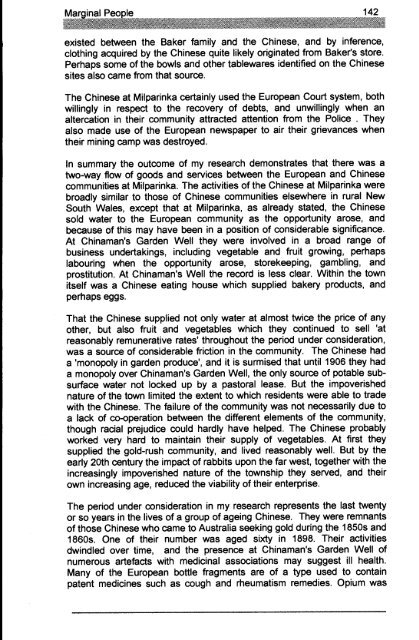Adec Preview Generated PDF File - The Sydney eScholarship ...
Adec Preview Generated PDF File - The Sydney eScholarship ...
Adec Preview Generated PDF File - The Sydney eScholarship ...
You also want an ePaper? Increase the reach of your titles
YUMPU automatically turns print PDFs into web optimized ePapers that Google loves.
existed between the Baker family and the Chinese, and by inference,<br />
clothing acquired by the Chinese quite likely originated from Baker's store.<br />
Perhaps some of the bowls and other tablewares identified on the Chinese<br />
sites also came from that source.<br />
<strong>The</strong> Chinese at Milparinka certainly used the European Court system, both<br />
willingly in respect to the recovery of debts, and unwillingly when an<br />
altercation in their community attracted attention from the Police . <strong>The</strong>y<br />
also made use of the European newspaper to air their grievances when<br />
their mining camp was destroyed.<br />
In summary the outcome of my research demonstrates that there was a<br />
two-way flow of goods and services between the European and Chinese<br />
communities at Milparinka. <strong>The</strong> activities of the Chinese at Milparinka were<br />
broadly similar to those of Chinese communities elsewhere in rural New<br />
South Wales, except that at Milparinka, as already stated, the Chinese<br />
sold water to the European community as the opportunity arose, and<br />
because of this may have been in a position of considerable significance.<br />
At Chinaman's Garden Well they were involved in a broad range of<br />
business undertakings, including vegetable and fruit growing, perhaps<br />
labouring when the opportunity arose, storekeeping, gambling, and<br />
prostitution. At Chinaman's Well the record is less clear. Within the town<br />
itself was a Chinese eating house which supplied bakery products, and<br />
perhaps eggs.<br />
That the Chinese supplied not only water at almost twice the price of any<br />
other, but also fruit and vegetables which they continued to sell 'at<br />
reasonably remunerative rates' throughout the period under consideration,<br />
was a source of considerable friction in the community. <strong>The</strong> Chinese had<br />
a 'monopoly in garden produce', and it is surmised that until 1906 they had<br />
a monopoly over Chinaman's Garden Well, the only source of potable subsurface<br />
water not locked up by a pastoral lease. But the impoverished<br />
nature of the town limited the extent to which residents were able to trade<br />
with the Chinese. <strong>The</strong> failure of the community was not necessarily due to<br />
a lack of co-operation between the different elements of the community,<br />
though racial prejudice could hardly have helped. <strong>The</strong> Chinese probably<br />
worked very hard to maintain their supply of vegetables. At first they<br />
supplied the gold-rush community, and lived reasonably well. But by the<br />
early 20th century the impact of rabbits upon the far west, together with the<br />
increasingly impoverished nature of the township they served, and their<br />
own increasing age, reduced the viability of their enterprise.<br />
<strong>The</strong> period under consideration in my research represents the last twenty<br />
or so years in the lives of a group of ageing Chinese. <strong>The</strong>y were remnants<br />
of those Chinese who came to Australia seeking gold during the 1850s and<br />
1860s. One of their number was aged sixty in 1898. <strong>The</strong>ir activities<br />
dwindled over time, and the presence at Chinaman's Garden Well of<br />
numerous artefacts with medicinal associations may suggest ill health.<br />
Many of the European bottle fragments are of a type used to contain<br />
patent medicines such as cough and rheumatism remedies. Opium was




